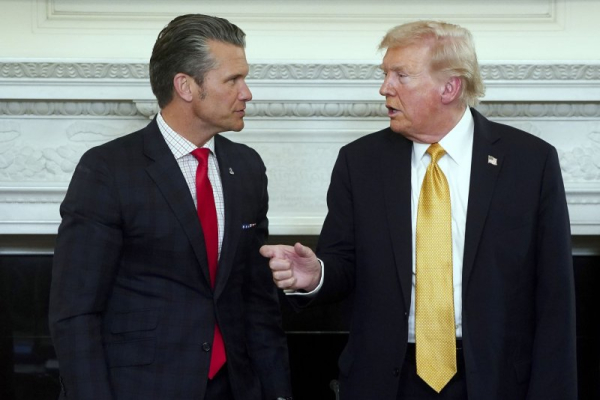U.S. interventions south of the border are almost as old as the nation


President Donald Trump speaks with Secretary of Defense Pete Hegseth during a roundtable with the Homeland Security Task Force in the State Dining Room of the White House in Washington on Thursday. Trump spoke about his administration’s attempts to thwart drug trafficking. Photo by Will Oliver/UPI | License Photo
With a U.S. Navy carrier strike group headed to the Caribbean to augment a naval armada there and President Donald Trump threatening not-so-covert operations and ground strikes against Venezuela, what is new?
Americans may not remember history, but U.S. interventions south of the border are almost as old as the nation. These are worth recalling, mainly because most failed or were misguided.
One hopes President Trump is listening or at least some of his advisors are.
From 1805 to 1807, a crisis and arrest of former Vice President Aaron Burr unfolded over a lunatic plan he had hatched. Burr wanted to raise a private army with the goals of seizing parts of Texas and Mexico and even creating a breakaway republic in what is now the southwest United States.
President Thomas Jefferson regarded Burr’s act as treasonous, leading to his arrest and famous trial at which Burr was acquitted.
From the 1810s to the 1890s, independence movements in Latin America inspired the U.S. to intervene — and to some degree, support them. The upshot was the Monroe Doctrine proclaimed by President James Monroe in 1823.
Monroe boldly and unilaterally declared the Western Hemisphere off-limits to European colonization. His doctrine became the foundation for rationalizing further U.S. interventions in the region.
From the1840s through the 1860s, Filibusters — privately organized military expeditions — spread throughout the region. In 1855, William Walker invaded Nicaragua. After making himself president and relegalizing slavery, he was overthrown and executed. Other Filibusters targeted Cuba, Honduras and Mexico.
The so-called Banana Wars broke out for nearly half a century from 1898 to 1934. In 1898, the United States seized Cuba, Puerto Rico, Guam and the Philippines and made Cuba a protectorate.
In 1903, the U.S.-backed Panamanian independence for Colombia to build the Panama Canal. U.S. Marines repeatedly occupied Nicaragua, Haiti, the Dominican Republic, Honduras and Cuba to protect U.S. companies there. And the United States roomed into Mexico to track down Pancho Villa in 1916.
In 1933, after he was elected, President Franklin Roosevelt installed the “Good Neighbor Policy,” which would last through the 1950s. FDR renounced the right to intervene and substituted diplomacy for sending in the Marines. One example was the creation of the Organization of American States in 1948.
The Cold War changed that philosophy.
In 1954, the CIA backed a coup to overthrow President Jacobo Arbenz of Guatemala after he began to appropriate the United Fruit Company two years earlier.
Fidel Castro’s revolution made Cuba an enemy. The 1961 failed Bay of Pigs invasion and the 1962 Cuban Missile Crisis followed.
In 1964, the United States supported the coup that overthrew Brazilian President Joao Goulart.
In 1973, in the name of defeating communism, the CIA was directed to destabilize Salvador Allende’s regime in Chile, installing the Augusto Pinochet dictatorship.
Ronald Reagan was nearly impeached over the Iran-Contra scandal and the efforts to overthrow the leftist Sandinistas in Nicaragua in the mid-1980’s. Since the Boland Amendments forbade U.S. support of the Contras, a bizarre scheme was contrived to send weapons to Israel, which would then send funds to the Contras.
And during that period, the Unaided right wing groups in Salvador, Guatemala and Honduras operated largely without direct U.S. sponsorship, underscoring the difference between overt support for the Contras and Washington’s tacit tolerance of right‑wing paramilitaries elsewhere in Central America.
In 1983, in Operation Open Fury, the United States invaded Grenada on the concocted grounds of saving U.S. medical students who were in no danger. The invasion was a farce. And the cause célèbre, a runway being constructed there by Cuban labor, was in fact paid for by the United Kingdom government to increase tourism.
In 1989, Operation Just Cause invaded Panama and deposed dictator Gen. Manuel Noriega and restore a democratically elected government.
The United States passed the North American Free Trade Agreement linking the United States Canada and Mexico, and America aided Colombia with Plan Colombia to fight the drug war.
Tensions with Venezuela and its presidents, Hugo Chavez and now Nikolas Maduro, have now escalated to the point that regime change is no longer out of the question. And while President Barack Obama restored relations with Cuba, relations have deteriorated.
The Trump administration has declared an undeclared war with the Southern Hemisphere over illegal immigration and closing the borders to block drugs. It also has impacted trade with Latin America by imposing tariffs. And Donald Trump has supported Argentine President Javier Milei with at least $20 billion in loans.
Where this new drug war, which included blowing up alleged drug boats, goes is uncertain. Venezuela is not the drug capital of the world or this hemisphere. Colombia and Mexico are strategic centers of the drug trade.
But, U.S. policy south of the border has come full circle. And the Donroe Doctrine may be applicable now.
Harlan Ullman is UPI’s Arnaud de Borchgrave Distinguished Columnist, senior adviser at Washington’s Atlantic Council, chairman of a private company and principal author of the doctrine of shock and awe. His next book, co-written with Field Marshal The Lord David Richards, former U.K. chief of defense and due out next year, is Who Thinks Best Wins: Preventing Strategic Catastrophe. The writer can be reached on X @harlankullman.